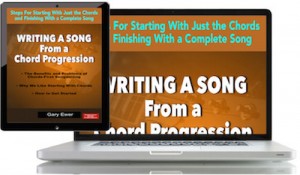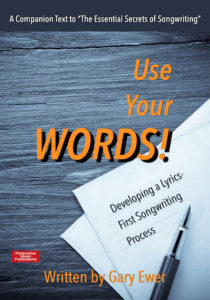How do you know when a song is finished? In days gone by, you’d get a song working as best you could in some barebones fashion, record a demo that, for all its roughness and edges, sounded reasonably complete. At least complete enough that a producer could then make decisions about what the final version should sound like.
These days, technology has made it possible for songwriters to get what sounds like a finished version, and to get to that version very quickly. Using nothing more than a computer or even smartphone, you’ve got the ability to do all steps of the process that takes you from songwriting through to recorded master.
 If you like starting songs by working out the chord progression first, you will love “Writing a Song From a Chord Progression.” It’s part of the 10-eBook “Essential Secrets of Songwriting” Bundle.
If you like starting songs by working out the chord progression first, you will love “Writing a Song From a Chord Progression.” It’s part of the 10-eBook “Essential Secrets of Songwriting” Bundle.
That benefit of technology is also its Achilles heel; the line between songwriting and producing has become enormously fuzzy. For many songwriters, there is no obvious switch between the writing stage and the producing stage. Some see that as a benefit, allowing for a more integrated songwriting approach.
But the problem is that songs need to work on a structural level, and production might simply be masking those structural deficiencies.
What We Mean By “Structural Problems”
When a song sounds great, you might credit many things that aren’t specifically songwriting attributes. You might like the performance, for example. You might enjoy certain sound effects, the edginess of the guitars, the energetic tempo, and so on. These aren’t strictly songwriting elements; those are production-level decisions that every songwriter/performer eventually makes.
But when a song sounds weak, you need to consider the possibility that the problem lies in the actual structural “bones” of the song. These structural bones might be:
- The contour of the various melodies.
- The choice of chords.
- The way the chords and melody relate.
- The strength of the partnership of the chords, melody and lyric.
- In general, the adherence to the principles of good songwriting.
The problem is that many of those songwriting weaknesses can be dealt with by a bandage solution known as production. Good production was never meant to solve songwriting problems. Good production is a feature in its own right, a feature that works best when applied to a structurally solid song.
As an example, look at point #1 above, the contour of various melodies. We know that verse melodies typically start low, move higher, and join onto a chorus melody that sits higher in pitch. Why is that important? Because the voice that sings that melody displays more musical energy as it moves higher, and that goes hand-in-hand with an important songwriting principle: that a song’s energy should increase as a song moves forward.
If your melodies don’t do that, you will notice a lagging of musical energy in your song, a lagging that you might be tempted to fix with production: make everything louder as you go… that ought to do it.
But the better solution is to get the melodies working properly first. Put the magnifying glass on your song melodies and ensure that they’re moving in the right direction so that the song has a natural energy build.
Once you’ve done that, any production you add similarly sounds natural and pleasant.
Solving Structural Problems
So what’s the best way to solve songwriting problems these days, even if you’re using technology from the very first stage?
I believe the best solution is to create a very simple version of your song, as simple as you can possibly make it. What that might be depends on the nature of your song, and the characteristics you want audiences to focus on. So that might mean:
- Sing an unaccompanied version. Though your finished version might include lots of production with a huge instrumentation, strip it all down to just your vocal line, no instrumentation added. Do you like the melody? Do you notice anything odd? Your song should work in this version.
- Sing this unaccompanied version with a chording instrument. Do you like the chords? Try substituting some chords and see if you come up with anything better.
- Experiment with tempo. Do you like your original tempo? Does the melody/chords/lyric sound better when you sing faster? Slower?
- Read your lyric. Try reading the lyric as prose, or as a simple poem. Does it say what you need it to say? Try different ways of saying it. Find other possible internal rhythms. Now read it melodramatically, with lots of ups and downs in your reading style. Can you hear other melodic possibilities coming forward?
It’s important as a songwriter to do this kind of scrutiny before you get too much into the production of your song. By doing this, you are able to solve problems that result in a structurally solid song.
And that almost always makes production sound a whole lot better.
 Written by Gary Ewer. Follow Gary on Twitter
Written by Gary Ewer. Follow Gary on Twitter
 The FREE DEAL continues! Get a free copy of “Use Your Words! Developing a Lyrics-First Songwriting Process” when you purchase “The Essential Secrets of Songwriting 10-eBook Bundle”
The FREE DEAL continues! Get a free copy of “Use Your Words! Developing a Lyrics-First Songwriting Process” when you purchase “The Essential Secrets of Songwriting 10-eBook Bundle”











Strongly agree with you and Peter Wood-Jenkins. Songwriting is an art in its own right, as is production. When one conceives their song by early on thinking how it will look and sound in a video, much can get lost in the search for glitter.
Really good songs can captivate when performed in a coffeehouse setting with just one solid performer. A friend of mine, Vance Gilbert, just blows me away with his songs in a coffee house setting and since has worked with some big name artists, too. You might try to catch him in a solo performance if you can. I especially appreciate his “Witness To Joy” song.
A Simple answer is Can Your Song Be Performed by one man or
woman with a guitar and sound good
Embellishment should come later Bare Bones comes first The
problem is how many A and R staff recognise a song in a
Bare Bones recording ????
Not many Just think of all the songs released by major recording
company’s that have failed to chart
Good point, Peter. I think that the bare bones version serves well, though, as a crucial step before adding production, and before an A&R person would get to hear the song. In other words, bare bones as a part of the songwriting process.
-G